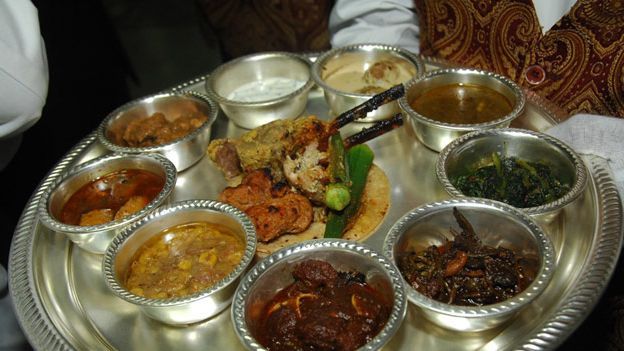Food of the Mewar Royal Family: A Legacy of Flavor and Elegance

Introduction
The royal kitchens of Mewar, a region rich in history, have shaped its culinary legacy for centuries. Mewar’s royal family didn’t just create meals; they crafted experiences. Their cuisine reflects the culture, traditions, and hospitality of this ancient kingdom. The flavors of Mewar are bold and refined, combining regional ingredients with elegance. This article takes you on a journey through the legacy of Mewar’s royal cuisine, exploring its rich flavors, unique ingredients, and time-honored traditions.
The Royal Kitchens of Mewar: A Legacy of Opulence
The Mewar kingdom, with its capital in Udaipur, is one of Rajasthan’s most historic regions. Its royal family played a pivotal role in shaping both culture and cuisine. The kitchens once hosted elaborate preparations and grand feasts to celebrate victories, weddings, and festivals. Royal banquets were more than meals; they were celebrations of the family’s wealth and hospitality.
The royal kitchens sourced ingredients from across the kingdom. Spices, herbs, and vegetables were common in Mewar’s cooking, while dry fruits, nuts, and dairy products featured in many royal dishes. The royal family’s patronage of the culinary arts encouraged the creation of complex recipes. These dishes reflected the sophistication of Mewar’s court.
Signature Dishes of the Mewar Royal Family
-
Dal Baati Churma: Dal Baati Churma is a signature Rajasthani dish, originating from Mewar’s royal kitchens. This hearty combination of lentils (dal), round wheat dumplings (baati), and a sweet, crumbly mixture of flour and ghee (churma) represents the balance of savory, sweet, and spicy flavors. The royal version of this dish uses rich ghee and aromatic spices, elevating it for feasts and special occasions.
-
Gatta Curry: Gatta Curry, a traditional dish made with gram flour dumplings, is another royal favorite. The dumplings cook in a spicy, yogurt-based curry, enhanced by cumin, coriander, and garam masala. This vegetarian dish often featured in royal meals, offering comforting flavors in every bite.
-
Laal Maas: Laal Maas, a fiery mutton dish, showcases Mewar’s bold flavors. Tender mutton stews in a rich, spicy gravy of red chili, garlic, and a mix of traditional spices. Reserved for special events and served to esteemed guests, Laal Maas embodies the bravery and strength associated with Mewar’s royal warriors.
-
Mewar Pulao: The Mewar Pulao, an aromatic rice dish, remains a staple in royal meals. It’s cooked with whole spices like cinnamon, cloves, and cardamom, with dry fruits for added texture and flavor. The Mewar Pulao is a perfect accompaniment to any meal, showcasing the royal family’s love for aromatic rice dishes.
-
Kesar Ghevar: Kesar Ghevar, a dessert crafted from flour, ghee, and sugar syrup, is often flavored with saffron, giving it a rich aroma and luxurious yellow color. This royal treat is served during major celebrations like Teej and Raksha Bandhan, symbolizing the Mewar royal family’s refined taste in desserts.
Ingredients and Cooking Techniques in Mewar Cuisine
Mewar’s royal kitchens relied on high-quality ingredients to create rich and flavorful food dishes. Spices like cumin, coriander, turmeric, and garam masala were essential for creating aromatic curries and stews. Ghee, or clarified butter, enriched many dishes, adding depth and richness.
Meat, particularly mutton, played a central role in Mewar’s royal cuisine. It symbolized strength and stamina, vital traits for the warriors. In addition to meat, rice, lentils, and vegetables formed the core of the diet. Slow cooking and simmering were common techniques used in royal kitchens, allowing the flavors to deepen and develop complexity.
Royal Feasts and Dining Traditions
Dining in the Mewar royal family was an elegant affair, where guests were treated with the utmost hospitality. The royal kitchens served multi-course meals during banquets, showcasing the culinary skills of the chefs. These feasts were not just about food but about creating an experience. The meals often took place in lavish settings, accompanied by music, dance, and entertainment.
The dining table would feature an array of dishes, from spicy curries to sweet desserts, ensuring there was something for everyone. The royal family dined together, surrounded by courtiers and noble guests, while celebrations filled the air. The grandeur of the royal meals created an unforgettable atmosphere.
Conclusion
The food of the Mewar royal family continues to stand as a testament to the region’s cultural and culinary legacy. From the rich spices to the meticulous preparation, Mewar’s royal cuisine highlights the family’s love for flavor and elegance. Today, these dishes remain part of the region’s culinary identity, celebrated in both royal kitchens and local homes. The flavors of Mewar are not only delicious but are steeped in history and tradition, making them an enduring symbol of Rajasthan’s regal heritage.
Whether it’s the fiery Laal Maas, comforting Dal Baati Churma, or sweet Kesar Ghevar, Mewar’s royal food takes us back in time, reminding us of a legacy of flavor and elegance that continues to captivate the senses.






